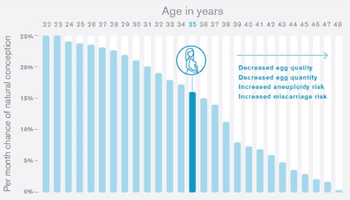According to Genea fertility specialist Dr Devora Lieberman, women pursue egg freezing for different reasons but many ultimately see it as empowering. “for many women, it’s about taking control of their fertility,” she says.
“Many of my egg freezing patients explain their treatment as an insurance against regret. It’s about knowing later in life that you did all you could at the time, that you investigated all the options.”
At the same time, it’s important to know there are no guarantees when it comes to freezing your eggs. As Dr Lieberman says, only around 10% of patients who undergo the procedure will return to use their eggs down the line, so there’s not enough meaningful data yet to indicate the success rate of going on to have a baby. Also, circumstances for women change over time: some will go on to have a baby naturally, while others will decide they simply don’t want to have children.
Below, with the help of Genea, we’ve listed a number of key things to know about egg freezing:
We’re born with the eggs we’ll have for our entire lives
The average woman is born with around two million eggs in her ovaries. By the time she has her first period, the number of eggs is around 400,000 to 500,000. From there, the quality of eggs decreases with age. According to Genea, a 36-year-old woman who is sexually active has a 15 per cent chance of falling pregnant each month. By the time she reaches 45, the average natural fertility rate is just 1% per month.
A woman’s fertility peaks around age 22
That means your early twenties is also probably the best time to consider egg freezing – but this is often the last thing a woman at this age is thinking about. According to a recent Women’s Agenda/Genea poll, just 15 per cent of those surveyed suggested women should do this between the ages of 21 and 25, 47 per cent said it should be done between 26 and 30, and 33 percent suggested the optimal age was actually between 31 and 41.
Technology has dramatically improved the process of freezing eggs
Similar to snap freezing, the vitrification process freezes eggs in a couple of minutes at -196 degrees. The older freezing method took longer so had the potential to compromise egg quality. The process involves putting the eggs in the vitrification solution, which instantaneously solidifies into a glass-like structure. At Genea, they use an automated process developed in-house in an instrument called Gavi. The rapid cooling process helps avoid damage caused to the genetic material of the egg that can occur through slower cooling processes.
Egg freezing takes around two weeks
The process includes three steps: stimulating the ovaries; egg collection and egg vitrification & storage.
Dr Lieberman explains that the process begins with a series of follicle stimulating injections on the first day of a woman’s period. The objective is to “encourage more follicles to mature than in a natural cycle, when typically only one follicle develops,” she says.
From here, patients will undergo a range of blood tests and ultrasounds from about day seven of her cycle, and typically every other day until the follicles are big enough to have a mature egg.
Once they’re mature enough, (usually between day eight and 12) patients need to have another injection that triggers ovulation. The collection process occurs just before the eggs are released. “A doctor will access the follicles via the vagina and guided by ultrasound will place a fine needle into each follicle, collecting any eggs.”



